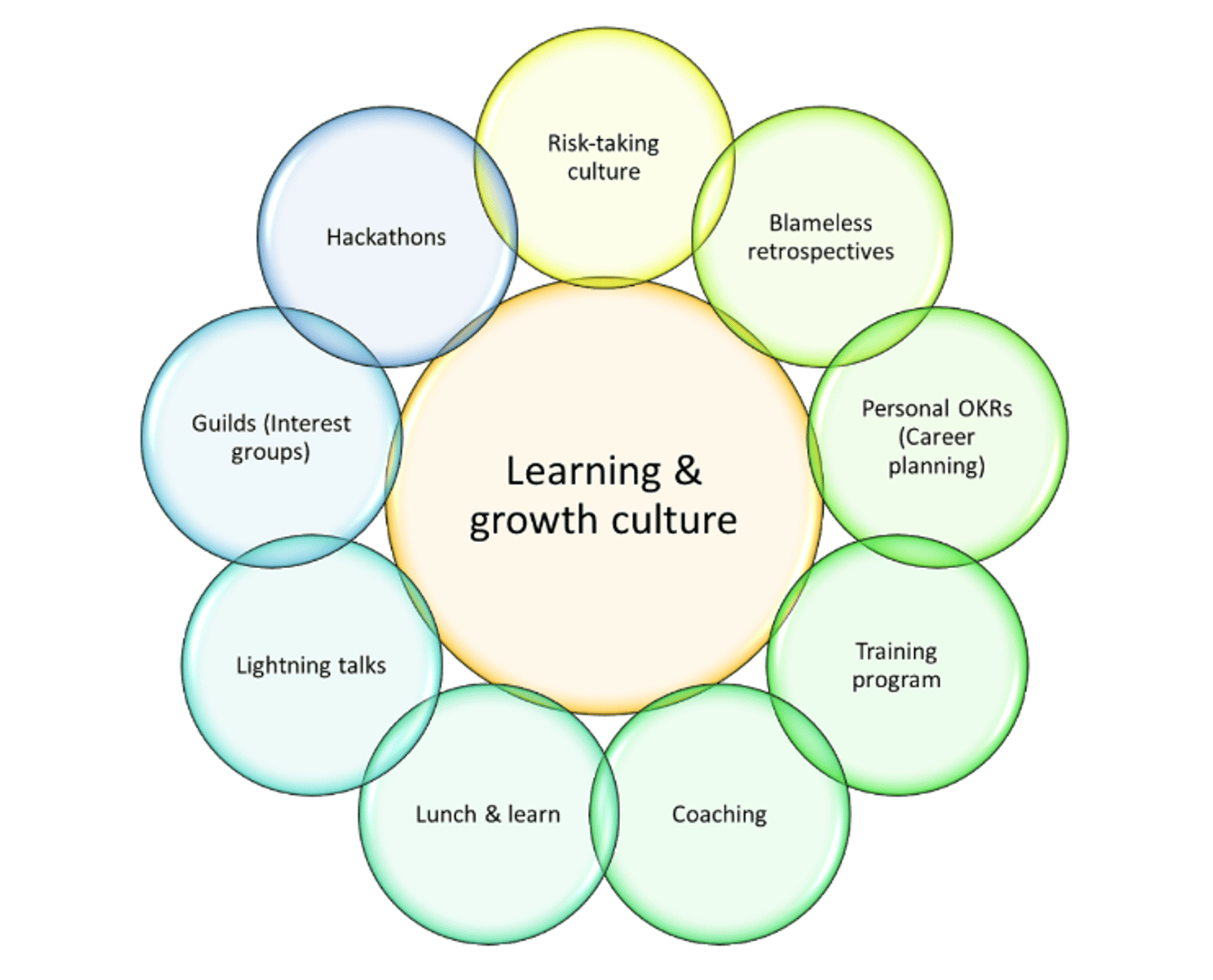Why a learning culture is important – and why your organization needs one

Published 2023-09-27
Summary - At Klipfolio, we believe that continuous learning is like blood in the veins of an engineering organization. If the learning stops, innovation stops. And if innovation stops, so does progress. Products lose their competitive edge and, more importantly, so do employees. The best people are eager to learn and grow; if they can’t, they disengage and look for an employer more
At Klipfolio, we believe that continuous learning is like blood in the veins of an engineering organization.
If the learning stops, innovation stops. And if innovation stops, so does progress.
Products lose their competitive edge and, more importantly, so do employees. The best people are eager to learn and grow; if they can’t, they disengage and look for an employer more attuned to their needs.
We have worked, by experimenting with different solutions, to build a culture of continuous learning at Klipfolio.
In this post, we will talk about the essential elements of a learning culture, as well as the initiatives leaders can take to facilitate and nurture such a culture.
What is a learning culture, and why is it important?
A work environment with a learning culture is one in which employees are encouraged to learn and grow.
That may seem self-evident, but in fact, it’s not. Some companies, for example, may value compliance with the rules over risk-taking, or blame people for failures rather than see the occasional failure as a learning opportunity.
Much has been written about creating a culture of continuous learning, but four pieces stand out. They are references for managers looking to learn more on the topic.
- In his book, Drive, author Daniel Pink argues that money is not the best way to motivate employees. People, he says, perform better and are more satisfied with their jobs when they feel they can direct their own lives, learn and create new things, and improve themselves and the world. He calls these three motivators autonomy, mastery, and purpose. ‘Mastery’, one of the three, is achieved through learning.
- American sociologist Ron Westrum is an expert on organizational culture. Through his research, he concluded that there are three kinds of organizations – pathological (power-oriented), bureaucratic (rules-oriented), and generative (performance-oriented). (See here and here for a more detailed explanation of Westrum’s work.) A crucial element of a performance-oriented work culture, he says, is the ability to learn from failures; that means making occasional failures acceptable within the organization.
- Google has done its own research and concluded that psychological safety – being able to take risks without feeling embarrassed by failures – is an essential element of a successful team.
- The State of DevOps 2018 report identifies the climate for learning as one of the contributing factors to software delivery performance and successful teams. (The report represents five years of work surveying over 30,000 technical professionals worldwide.)
How we built our own culture of learning
From Klipfolio’s perspective, having a learning culture is important for two main reasons.
First, it allows us to build great work teams. Our teams learn so they can build the skills they need to get their work done.
Second, having a learning culture is critically important for employee engagement and retention. Employees who feel they can develop and hone their skills are more likely to be engaged. And employees who are engaged are better employees.
For those reasons, over time we’ve built our own culture of learning.
How?
We did it through research and a bit of experimentation. As we built it, we also got our employees involved. We regularly survey them to ask them whether they feel they are learning and advancing their careers. Their feedback is critical – and part of the reason we think our learning culture has been a success.
The 9 elements of our learning and growth culture
There are nine elements to our learning and growth culture:
- We encourage risk-taking and experimentation
- We encourage blameless retrospectives and post-mortems
- We have a growth framework based on objectives and key results (OKRs)
- We have a training program for employees
- We have a coaching program for employees
- We offer what we call ‘lightning talks’ in the office
- We organize lunch and learn sessions
- We encourage the formation of groups of similar interests; we call them guilds
- We hold hackathons

Risk-taking and experimentation
We believe very strongly that engineers who stay within their comfort zone are not going to learn and grow. We also believe that if people are afraid of failure, they will choose the safe path, not the risky one, and fall back into their comfort zone.
Progress and innovation demand risk-taking. Innovations happen and new products, tools, or processes are built when people push the norms.
It is also true that people who don’t push the norms stagnate. Employees who are bored are apt to leave you for other, more stimulating employers. As leaders, we are responsible for helping people take risks and jump from one growth curve to the next.
One example of risk-taking is how tasks are allocated. We often encourage tasks to be picked up by the next available developer, instead of the developer with the most expertise in an area. This encourages a developer to learn something new, reduces our “bus” factor, and may bring new perspectives to that area of the product.
For those two reasons, it is actually cost-effective to favour risk-taking over the safe path.
Blameless retrospectives and post-mortems
A necessary part of a risk-taking culture is making failure acceptable (within reason). It also means making blameless retrospectives a regular and frequent activity in the organization. We use retrospectives to look back on production incidents, large features, and each sprint to reflect on what could be improved going forward. The retrospectives are used to build a shared understanding of any problems and provide a forum to discuss improvements, not to assign blame.
Going back to Ron Westrum’s three organization types, the generative, performance-oriented type (which is what we aspire to be) encourages learning from failures; the pathological, power-oriented type finds scapegoats when things go wrong; the bureaucratic, rules-oriented type raps people on the knuckles.
A growth framework based on objectives and key results (OKRs)
Various forms of goal-setting frameworks can be used to help people achieve their dreams. We like the OKR system because it focuses on aspirational goals and measurable outcomes. Also, it links personal objectives to the organization’s goals, thereby creating a win-win situation for people and the business.
As part of our quarterly OKR-based goal-setting program, we review every employee’s objectives and the key results they are aiming for. Then we make sure these help employees get to where they are heading personally, while aligning their goals with where we want to go as an organization.
Employee training
Our training program provides the means for employees to learn what they need to learn. We have a training budget, too, and we give each employee dedicated time that they can allocate to learning.
The budget allows them to buy online courses and books, or go to conferences. The dedicated time for training keeps work-life balance in check so that people don’t have to spend all their personal time on their growth, and have time for their families and fun too.
We also provide in-house training sessions when we believe a group of people would benefit from learning about the same topic together.
Employee coaching
A coaching program is an essential element of a learning culture. Done right, it also results in cross-pollination and knowledge-sharing between teams – breaking down silos and reducing the implied hierarchy of seniority in the group.
In other words, a great coaching program focuses on helping people learn from each other; it’s not just about senior people teaching others.
When we organize a coaching program, we emphasize mutual learning opportunities for both the coach and the mentee. We encourage cross-team coaching. And we make it clear that a mentor or coach is someone who has something to share, not just someone with seniority and tenure. Team leaders should lead by example and make sure they have mentors both senior and junior to learn about the topics that they are not familiar with.
We organized the coaching program this year, and it has been a resounding success with about half the development team signing up as either a coach or mentee.
Lightning talks
In an engineering team, people are learning continuously and naturally as they work on new tasks, solve problems, and use new technologies. However, sometimes this knowledge remains within the group and does not get shared as much as it could.
By lowering the barriers to sharing experience, you can foster a culture of sharing and learning.
Lightning talks are an effective way of making this happen.
These are talks that are offered in the office. Presenters don’t need slides; if they want to, they can just show code or whatever else they are working on. Talks can be as short as 10 minutes and don’t have to be on big novel topics. Anything that people have been working on and learn from is fair game and worth sharing. A nice side effect of encouraging lightning talks is that team members get a chance to practice their communication skills, which will help them as they grow their career.
Lunch and learns
As the name implies, this is an initiative that encourages teams to get together, have lunch, and learn something new. The way we usually do them is by watching online tutorials or by doing mini code challenges. The frequency and length of these sessions depends on the team’s end goal, which can be anything from learning a new technology for an upcoming project to brushing up on old concepts.
Attendance at these sessions is voluntary and they are meant to be held in a relaxed setting to foster learning. The most successful lunch and learns are those that are small in numbers (three to eight people) and attended by people who already know each other; this ensures that everyone is comfortable enough to be vulnerable and ask as many questions as possible. After all, you want employees to be engaged and have fun.
Guilds (groups with similar interests)
Our guilds are interest groups focused on specific topics. At Klipfolio, these groups get together every two weeks or so to discuss their topic of interest in depth and move that topic forward in the team and for the company.
For instance, at Klipfolio we have UI, platform, agile, data science, and automation guilds, to name a few. These guilds have been instrumental in knowledge-sharing and creating in-depth discussions and talks, as well as bringing in new ideas to the company on those topics.
Hackathons
Many engineers learn by doing and are excited by the prospect of trying new things. Often, when there are deadlines and day-to-day tasks to complete, people focus on what they have to do. They don’t have the occasion to free their minds to explore.
Hackathons facilitate risk-taking by allowing employees to experiment with new methods, technologies, or work with other engineers who are not on their own team.
During the last hackathon, seven developers got together to try a new animation library. This resulted in a much better shared understanding of how to implement animations, and a decision to move forward with this particular library. Many of these animations have now made it into the product.
In conclusion
I don’t pretend that we have discovered the secret of continuous learning. The methods I have discussed here are methods we use successfully; there are certainly others. And in keeping with the spirit of continuous learning, we are always on the lookout for better ways of doing things.
But what stands out overall is this:
To foster a culture of learning, you need a multi-faceted strategy that combines traditional methods of learning like formal training with organic methods or learning on the job.
We’ve done so by facilitating guilds, coaching, hackathons and lightning talks.
And being able to take risks is an essential part of the mix.
Many engineers learn best by discovery. But for them to discover new things, they have to step out for their comfort zone and take risks. And they’ll only do that if failure is acceptable in the organization’s culture.
- Ali Pourshahid, Ph.D., is the VP of Software Development at Klipfolio. He can be reached at @ali_pourshahid.
- Natalia Castillo is a software development manager at Klipfolio. She can be reached at @castlenat.
- Gianna Mauro is a software development manager at Klipfolio. She can be reach via her LinkedIn.
Related Articles

Klipfolio Partner How-To #1: Duplicating dashboards across client accounts
By Stef Reid — November 27th, 2025
Klipfolio Partner How-To #2: Company Properties can simplify client set-up
By Stef Reid — November 26th, 2025
12 Important Sales Enablement Metrics You Shouldn't Miss
By Grace Lau — September 19th, 2025

